|
CONTENTS
Stan Musial and Ted Williams - I
Stan Musial and Ted Williams - II
Duke Snider
Walter Johnson
Carl Hubbell
Jim Bottomley
Andy Pettitte
Goose Goslin
Early Wynn
Willie Stargell 1971 Post-Season
Greats Bad Days - I
Greats Bad Days - III
Baseball
Page
Golden
Rankings Home
Top
of Page
|
Even
the Greats Have Bad Days – II
This feature discusses a game or series in which an outstanding player did not perform
well.
Stan Musial and Ted Williams - I
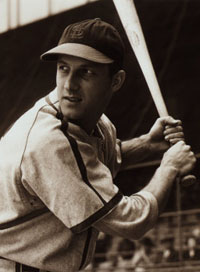
Stan Musial
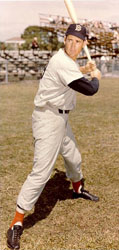
Ted Williams
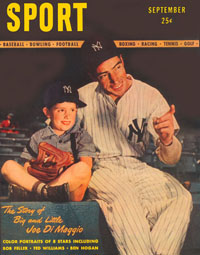
Joe DiMaggio
Top of Page
|
The 1946 season saw baseball return to its pre-World War II glory. The Cardinals and Red Sox won their respective pennants led by the MVP in each league.
- 25-year-old Stan Musial, having missed the '45 season while in the Navy, led the senior circuit in batting average (.365), slugging percentage (.587), on-base plus slugging (a stat not kept at the time), runs, total bases, doubles, and triples. Is it any wonder that he won the NL MVP voting by 160 points over Dixie Walker of Brooklyn or that the The Sporting News proclaimed Musial as the Major League Player of the Year?
- Ted Williams, back at age 27 after missing three seasons in military service, dominated the AL in a similar fashion. He hit .342 to finish second in that department (to Mickey Vernon of Washington) and led the league in on-base % (.497), slugging % (.667), on-base plus slugging, runs, and total bases.
Fans who had turned out in record numbers at ML ballparks relished the Fall Classic's promise of a head-to-head duel between the two best players in the game. However, several factors militated against Teddy Ballgame performing on all cylinders.
- The start of the World Series, originally scheduled for Wednesday, October 2, had to wait for the first-ever pennant playoff. The Cardinals and Dodgers met in a best-of-three series to decide the NL championship.
- Having clinched their first pennant since 1918 on September 13, the Red Sox had coasted the last two weeks. Fearing rustiness from a further layoff, they enlisted help from their AL rivals. League president Will Harridge rounded up a group of All-Stars to play three games against the Bosox to keep them sharp.
- In the first game of the warmup series, Williams was hit on the right elbow by a curve from southpaw Mickey Haefner. Taking whirlpool treatments to help heal the badly bruised bone, Ted sat out the last two practice games.
On October 5, just as the World Series was about to begin after the Cards took two in a row from Brooklyn, a big distraction affected the Red Sox in general and Williams in particular.
- Rumors of a Ted Williams-for-Joe DiMaggio trade resurfaced. The idea was that each man was better suited to the other's home park. Fenway had the Green Monster in LF, ideal for the right-handed hitting Yankee Clipper, while Yankee Stadium had one of the shortest RFs in baseball for the left-handed Splendid Splinter. A deal had been discussed earlier in the season but had broken down on both sides.
- The latest story eminated from a singer named Betty Sharp, who claimed to be Joltin' Joe's fiancee, even flashing an engagement ring. She told The Boston Globe she was in Beantown looking for an apartment for the 1947 season when Joe would be playing for the Red Sox.
- DiMaggio, who had just participated in the practice games in Boston, admitted to dating Miss Sharp twice but insisted that they weren't engaged and he knew nothing about any trade.
- Boston manager Joe Cronin said there was nothing to the rumor and added that it "looks like a National League plot." However, Williams was upset by the trade talk, tellling his teammates that he would jump to the new Mexican League rather than play in New York.
- Another rumor claimed that Ted would be traded alright, but to the Tigers for P Hal Newhouser and OF Dick Wakefield.
- Red Sox owner Tom Yawkey didn't explicitly deny the rumors, saying only that, "I wouldn't dignify these matters with comment."
Meanwhile, Stan, who had played in all 156 Redbird games, had no such ailments or distractions as the Series began in St. Louis on Sunday, October 6.
Reference: Ted Williams: A Baseball Life, Michael Seidel (1991) |
Stan Musial and Ted Williams - II
When Stan Musial and Ted Williams squared off in the 1946 World Series, it was The Man's fourth in as many full seasons in the majors while Ted experienced his first Fall Classic. Never again would either Hall of Famer make it to the post-season.
Game One @Sportsman's Park, St. Louis: Red Sox 3 Cardinals 2 (10 innings)
- As suspected, the Cardinals unveiled their version of the Williams Shift popularized by Cleveland manager Lou Boudreau. St. Louis manager Eddie Dyer moved 3B Whitey Kurowski to the 2B position but closer toward the bag with 2B Red Schoendienst and 1B Musial to Whitey 's left.
- Cardinal scouts had been following the Red Sox for weeks. Concluding that Williams could hit anything, the advance men recommended that the staff take chances, even throwing to his power, rather than fall into patterns. Keep him guessing.
- Ted, in his own words after Game One, "singled to right over the third baseman's head." That was his only hit in 3 ABs with 2 BBs.
- Musial rapped a double off the RF wall in the 6th to drive in the Cards' first run of the Series and tie the game. However, he produced nothing his other four trips to the plate, failing to drive home the tying run from 2B with one out in the tenth.
Game Two @ St. Louis: Cardinals 3 Red Sox 0
- Neither hero managed a hit in 4 ABs.
- Lefty Harry Brecheen mesmerized Williams and all the Boston batters with a 4-hitter. Ted: "Brecheen's pitches look nice to hit at, but when you try to hit him the ball just isn't where you think it's going to be." Ted also made the point that the P always has the advantage over the hitter who hasn't seen him before.
- Stan drove in the final run with a ground out in the 5th. He ended the afternoon caught looking in the 8th.
Game Three @ Fenway Park, Boston: Red Sox 4 Cardinals 0
- Righty Dave "Boo" Ferriss turned the tables on the Cards with a 6-hit shutout.
- Musial walked in the first before grounding out twice. With two outs and the bases empty in the 9th, he smashed a standup triple to RF but died as Enos Slaughter struck out.
- The big news in Boston was that Williams bunted for a base hit down the 3B line in the third. He had been intentionally walked in the first with a man on second and two outs. However, Dyer's strategy backfired as Rudy York poled a HR over the Green Monster to provide Ferriss more than enough runs for the afternoon. Ted later struck out and lined to RF.
- If Red Sox fans were excited about Ted crossing up Dyer's shift, they would not see him bunt again in the Series. Years later, Willie Mays compared Musial to Williams, praising Stan for adjusting to pitches' locations and the defensive alignment while labeling Ted obstinate. "When they shifted on him [Williams], everybody to the right side, he still kept trying to pull the ball for hits. If anybody shifted like that on Musial, he would have wrecked them by slapping base hits into left."
- Hall of Fame manager Earl Weaver sounded a similar theme. "Musial was the best at adjusting once the ball left the P's hand. He'd hit the P's pitch. Williams was the best at making them throw his pitch." However, in the '46 Series, the Cards were determined not to throw Ted's pitch very often.
Game Four @ Boston: Cardinals 12 Red Sox 3
- The Birds feasted on Red Sox pitching to the tune of 20 hits. However, Red Sox contributed only one, a 2-run double to RCF, in five trips. His average after four games stood at a measly .176.
- Williams raised his average to .231 with a 1-for-3 afternoon. The hit was a 4th inning single, after which Red Sox drove him in with a double.
Game Five @ Boston: Red Sox 6 Cardinals 3
- The Bosox took a 3-to-2 Series lead behind the 4-hit pitching of curveballer Joe Dobson, who was Williams' favorite batting practice P.
- Musial had a double and a walk in four plate appearances. His base on balls led off the ninth, and he and Kurowski, who reached on an error, scored on Harry Walker's single. However, Dobson retired Marty Marion to end the game.
- Ted drove in the Sox first run in the first with a single to RF. That would be his only RBI of the Series and the only post-season RBI of his career. But the rest of the day went poorly, with four outs, including a strikeout against southpaw Alpha Brazle in the 5th with two on and none out. Two innings later, after Dom DiMaggio led off with a double, Brazle caught Ted looking.
Game Six @ St. Louis: Cardinals 4 Red Sox 1
- Brecheen kept the Redbirds alive to fight another day with a 7-hit complete game.
- Ted at least managed a meaningless 9th-inning single off Harry this time along with a walk. In his column in The Boston Globe the next day, Harold Kaese, Ted's unrelenting critic, wrote, "As matters stand, Ted Williams is an enormous bust."
- Musial legged out an infield single in 4 ABs and scored in the Cards 3-run 3rd.
Game Seven @ St. Louis: Cardinals 4 Red Sox 3
- The Red Sox had won all five World Series they had played in (1903 to 1918). And the Cardinals had never lost a seventh game. So something had to give on a sunny afternoon at Sportsmen's Park that produced the signature play of the Series.
- With one last chance to make a major impact on the Series, the two MVPs went out with a whimper.
- Ted was 0-for-4 to finish with an even .200 BA (5-25)
- Musial had a double and a walk in 3 official ABs to end at .222 (6-27). That brought his average for four Fall Classics to .256 (22-99) with 1 HR.
- Like Ted, Musial didn't have a multi-hit game in the '46 Classic. And neither man hit a HR. However, five of Stan's six hits went for extra bases.
- It was left to Enos Slaughter to be the hero of the Series, scoring from first on Harry Walker's double in the bottom of the 8th to give the Cards the lead that Brecheen, who entered in relief in the top of the inning, protected in the 9th to win his third game of the Series.
Williams always said that the biggest disappointment of his career was his performance in his lone World Series.
- Ted sat silently by his locker for half an hour after Game 7 before leaving the park.
- The day the Series ended, 11 Nazis who had been convicted at the Nuremberg Trials were hanged for their crimes. That same day, a few hours before he was to be executed, Field Marshal Hermann Goring committed suicide.
- A Red Sox fanatic claimed that Goring was actually more distraught over Williams' bad Series than his own conviction.
Reference: Ted Williams: A Baseball Life, Michael Seidel (1991)
Stan the Man: The Life and Times of Stan Musial, Wayne Stewart (2010)
Top of Page |
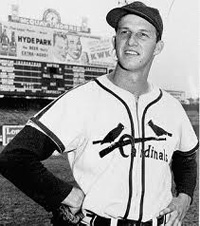
Stan Musial
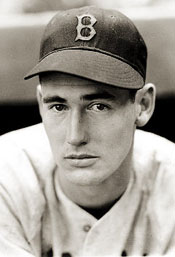
Ted Williams
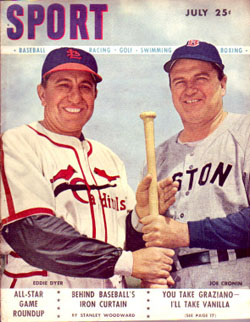
Eddie Dyer and Joe Cronin
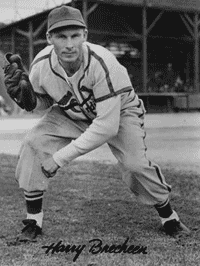
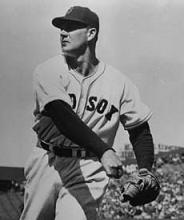
Joe Dobson
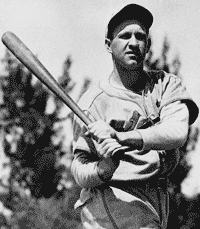
Enos Slaughter
|
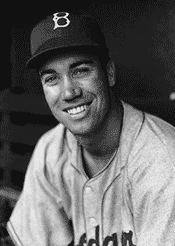
Duke Snider
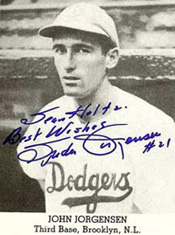
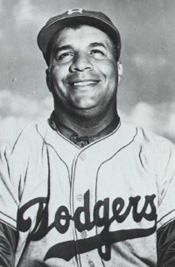
Roy Campanella
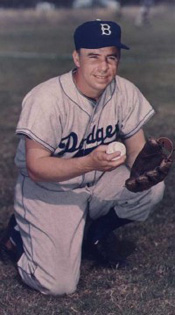
Pee Wee Reese
|
Brooklyn Dodgers CF Edwin "Duke" Snider had a miserable 1949 World Series. In his first full season in the majors that year, he hit .292 with 92 RBI and 23 HR. He also started establishing his reputation as an outstanding defensive player.
However, in the five-game Series, he got only 3 H (one 2B) in 21 AB with 0 HRs and 0 RBI. He led all batters from both teams with eight strikeouts. He did make some fine plays in CF, including robbing his Yankee counterpart, Joe DiMaggio, in his first two ABs in Game 5, leaping against the wall to catch The Clipper's SF in the first inning and racing in to make a shoestring catch on his liner in the third.
Here are The Duke's woes game-by-game.
Game One (Yankees 1, Dodgers 0)
- Batting third, struck out in the 1st with 3B Spider Jorgensen on second with a double.
- Fouled out in the 4th.
- Struck out with Jorgensen on first and no outs in the 6th.
Game Two (Dodgers 1, Yankees 0 – only time a Series has begun with two 1-0 games)
- Batting third, grounded to SS in 1st.
- Grounded to 2B in 3rd.
- Flied to CF in 6th with Jorgensen on second with a double and none out.
- Singled leading off the 9th against LHP Joe Page.
Game Three (Yankees 4, Dodgers 3)
- Batting 7th against LHP Tommy Byrne, flied to LF leading off the 3rd.
- In the 4th, ended the inning by grounding out with the bases loaded against Page.
- Grounded to first in 7th.
- Struck out in the 9th between HRs by LF Luis Olmo and C Roy Campanella.
Game Four (Yankees 6, Dodgers 4)
- Back in the 3rd hole against LHP Eddie Lopat, grounded to 3B in the first with Pee Wee Reese on 2nd and one out.
- 4th: Flied to RF with one out and none on.
- Hit into a DP with two on and none out in the 6th, an inning in which Brooklyn scored all 4 of its runs.
- Struck out in the 7th against RHP Allie Reynolds.
Game Five (Yankees 10, Dodgers 6)
- Batting 3rd against RHP Vic Raschi, struck out to end the 1st.
- Struck out leading off the 4th.
- Doubled leading off the 6th, scoring on Gene Hermanski's single.
- Singled again in the 7th, sending Jorgensen to third with one out; scored on Gil Hodges' 3-run HR.
- Struck out in the 9th with none out and Gene Miksis on second.
Snider played in four more Series for Brooklyn, not hitting less than .304 in any of them. His last Fall Classic appearance came with the Los Angeles Dodgers in 1959 when he hit .200 in only 10 plate appearances. He was inducted into Cooperstown in 1980. |
|
Walter Johnson is arguably the greatest RHP baseball has ever known. In addition to winning 417 games with generally inferior Washington Senators teams, he twirled a record 110 shutouts.
After 17 years with the Senators, Johnson finally got a chance to pitch in the World Series in 1924. He lost the opener to Art Nehf of the New York Giants in 12 innings, 4-3. Four days later, John McGraw's club beat him again 6-3, with three of the runs unearned. Pitching four scoreless innings in relief in Game Seven, Walter was the winning pitcher when the Senators plated a run in the bottom of the 12th.
When Washington amazingly won the AL pennant again in 1925, the "Big Train" pitched a five-hitter in the opener to defeat Pittsburgh 4-1. Then he outdid himself with a 4-0 victory in Game Four to give the Senators a 3-1 lead in games. No team had come back from such a deficit in the 21 Fall Classics to that point. Since Johnson had aggravated an old leg injury whlie running the bases in Game 4, he hoped he wouldn't have to take the mound again. However, the Pirates won Games 5 and 6. That set the stage for Game Seven at Forbes Field.
The 37-year-old rightie got a break when rain postponed the finale to give him a third day of rest. The field was still soaked the next day, but the game was not postponed again. In addition to battling the wet field and continuous rain, the players had to compete in a fog that enveloped Forbes Field. Washington LF Goose Goslin later said, "The fog was so thick I could just about make out what was going on in the IF from out there." Many at the time and down through the decades criticized the umpires and Commissioner Landis for playing the game under those conditions. The Pirates didn't relish the prospect of hitting Johnson's fast ball in poor visibility.
The home team's prospects looked even dimmer when the Senators struck for four in the first against Vic Aldridge. The score held up until the bottom of the third. Johnny Morrison, who relieved Aldridge, blooped a single to CF. Eddie Moore smacked a long double to LCF to plate Morrison for the first run off The Big Train in 15 innings. Max Carey singled home Moore to cut the lead in half. The premiere base stealer of the NL, Carey advanced to second on a groundout and then stole third. Clyde Barnhart singled him home.
Joe Harris doubled home two runs to put the visitors up 6-3 in the top of the fourth. Ray Kremer replaced Morrison and shut down the Senators for three innings. In the fifth, the Pirates plated a run on back-to-back doubles by Carey and Kiki Cuyler.
After a 1-2-3 sixth, Johnson started the 7th by getting Moore to pop up. But Roger Peckinpaugh, the AL's MVP and generally considered the top SS in the league, muffed it for his seventh error of the Series. Carey then laced his fourth hit of the game, a double that drove home Moore and cut the lead to 6-5. After a sacrifice and groundout, Walter had a chance to strand Carey at third. However, Pie Traynor tripled to the RCF fence to tie the game. An excellent relay caught Pie trying to stretch his hit into a homer.
20-30 years later, and certainly today, Johnson would not have stayed in the game to face Traynor. But in 1925 player-manager Bucky Harris sent his ace back to the slab for the eighth inning. He had the lead again after Peckinpaugh somewhat redeemed himself with a line shot over the LF fence. Walter retired the first two batters. Then C Earl Smith doubled to RCF. Carson Bigbee, hitting for Kremer, doubled over Goose Goslin's head in LF to tie the game. Still, Johnson labored on. He walked Moore. The pesky Carey then grounded to Peckinpaugh who fielded it cleanly but committed his eighth Series error with a wild throw to second for what would have been an inning-ending forceout. Peck went from goat to hero and back to goat. To compound his misery, Cuyler hit a ground rule double into the jubilant crowd in RF to give the Pirates a 9-7 lead.
Bucs manager Bill McKechnie sent Red Oldham to the hill, and he saved the game with a perfect ninth.
Johnson's line: 8 IP, 15 H, 9 R, 5 ER, 1 BB, 3 SO, 130 pitches
James Harrison wrote in the New York Times the next day:
In a grave of mud was buried Walter Johnson's amibition to join the select panel of pitchers who have won three victories in one World Series. With mud shackling his ankles and water running down his neck, the grand old man of baseball succumbed to weariness, a sore leg, wretched support and the most miserable weather conditions that ever confronted a pitcher.
Harris has also been blasted for keeping Johnson in the game. Even McKechnie said, "Johnson didn't seem to have much stuff out there today and the boys continued their clouting." AL President Ban Johnson sent Harris a telegram:
You put up a game fight. This I admire. Lost the series for sentimental reasons. This should never occur in a World Series.
|
|
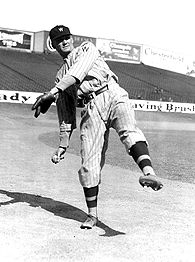
Walter Johnson
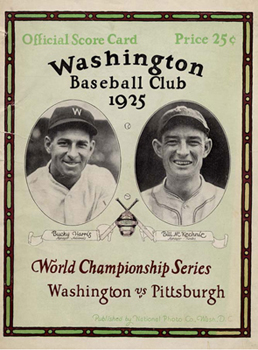
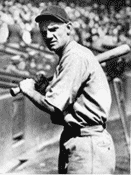
Max Carey
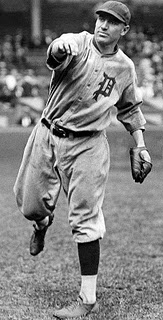
Pie Traynor
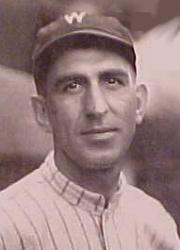
Roger Peckinpaugh
|
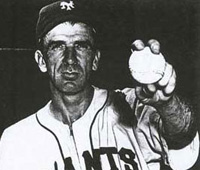
Carl Hubbell
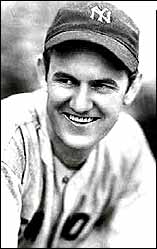
Lefty Gomez
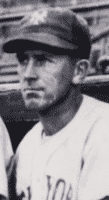
"Rowdy" Dick Bartell

Gus Mancuso
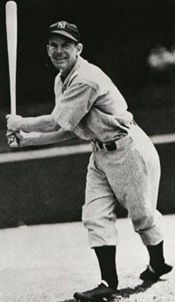
George Selkirk
|
Lefty Carl Hubbell of the New York Giants, widely considered the best pitcher in the NL, began the 1936 World Series by defeating the mighty New York Yankees 6-1. When the same two teams met in the 1937 Fall Classic, "King Carl" hoped to repeat his opening game magic.
Before a disappointing crowd of only 60,573 in Yankee Stadium on a muggy October afternoon, Hubbell was masterful for five innings, retiring eleven in a row after Joe DiMaggio's first inning single. The Giants pushed a run across in the fifth for a 1-0 lead.
Then Carl committed a double cardinal sin.
- He walked the leadoff man in the sixth inning.
- To make matters worse, that batter was his opposing moundsman, Lefty Gomez.
SS Frankie Crosetti, after attempting to bunt twice, singled to left to send Gomez to second. Next came the play that Giant manager Bill Terry called the "break of the game." With 3B Red Rolfe at the plate, C Gus Mancuso rifled a throw to catch Gomez off 2B. However, SS Dick Bartell dropped the ball as he tagged Lefty for an error. Rolfe then singled to left to load the bases. This brought up CF DiMaggio, in the second year of his Hall of Fame career.
- DiMaggio singled to left-center scoring Gomez and Crosetti to give the Yankees a 2-1 lead. Rolfe raced to third and DiMag took second on the throw to third.
- The Giants decided to walk 1B Lou Gehrig intentionally.
- C Bill Dickey hit a grounder that diving 2B Burgess Whitehead knocked down. Rolfe scored and the bases remained loaded. 3-1 Yanks
- LF Myril Hoag grounded to 3B Mel Ott, who forced DiMaggio at the plate.
- RF George Selkirk singled to plate Gehrig and Dickey and send Hoag to third. 5-1 Yanks.
Terry took out Hubbell and set off one of the strangest chains of events in World Series history.
- After a delay, RHP Dick Coffman finally appeared from the Giant bullpen in LCF.
- C Mancuso told home plate umpire Red Ormsby that Harry Gumbert was the new P.
- Accordingly, the stadium PA announced Gumbert as the new hurler.
- While Coffman warmed up, 3B coach Artie Fletcher, a former Giant, protested that Gumbert had to pitch to at least one batter since he had been announced.
- After conferring, the men in blue agreed with Fletcher and ordered the bewildered Gumbert to the mound from his spot in the dugout.
- Given only the minimum eight pitches allowed a reliever, Gumbert induced 2B Tony Lazzeri to hit a grounder up the middle that Whitehouse missed for another E.
- Coffman then replaced Gumbert and walked Gomez. This created another oddity – a P walking twice in the same inning.
- Crosetti flied to short left before Rolfe walked to force in a run.
- Finally, DiMaggio flied to CF to end the Giants' agony.
The Yankees tallied seven in the inning, all charged to Hubbell, although only four were earned. They added Lazzeri's solo HR in the eighth for an 8-1 triumph.
The Associated Press reported that Meeker OK "was deep in gloom, silent sorrow for the ill luck of this town's No. 1 citizen – Carl Owen Hubbell."
- The town had "locked up shop in high spirits this afternoon and crowded around radios to listen to G. O. Hubbell's boy pitch another world series game for the Giants."
- Carl's father said, "I hope that he has better luck next time. I guess we're kind of like the little boy who ran over the calf. We haven't much to say."
Three days later, Hubbell turned the tables on the Yankees in Game Four at the Polo Grounds.
- The Giants hit Bump Hadley with a six spot in the second, and Carl cruised to a 7-3 complete game victory.
- However, that was the Giants' only win in the series as the Yankees won the second of what would become four Series triumphs in a row.
Hubbell would never get a chance to pitch in the World Series again.
|
|
Left-hand hitting 1B Jim Bottomley compiled a .310 batting average during his 16-year ML career, the first 16 of which were with the St. Louis Cardinals. He was elected to the Hall of Fame by the Veterans Committee in 1974, 15 years after his death at age 59.
- He twice led the NL in RBI and total bases (1926 and 1928) and in doubles (1925-26).
- Sunny Jim hit .345 in his first World Series, helping the Cards upset New York in 1926. Two years later, he hit only .213 in the sweep by those same Yanks.
So neither Jim, his manager and teammates, nor the fans were prepared for his abysmal performance in the 1930 Fall Classic against the Philadelphia Athletics.
- Bottomley managed only one hit, a double, in 22 AB in the six-game A's victory. That's .045, decades below the Mendoza Line years before that term was invented. The only Fall Classic performance that's been worse was Gil Hodges 0-for-21 in 1952 for the Brooklyn Dodgers against the Yankees.
- Jim led all batters in strikeouts with 9 against Connie Mack's formidable left-right mound duo of Lefty Grove and George Earnshaw.
- Sunny's lone safety came in the 8th inning of Game 3 at St. Louis. He doubled over first with one out and then scored his only run of the Series on Chick Hafey's double.
- Several times Bottomley failed to advance or plate a runner.
- Game Two: Jim flied to CF to end the first inning with 2B Frankie Frisch on second.
- Game Five: With the teams tied with two wins apiece and the game scoreless in the bottom of the eighth, Sunny Jim struck out for the third straight time with Frisch on first. In the top of the ninth, Jimmy Foxx smashed a two-run HR deep into the LF bleachers for a 2-0 A's win.
- Game Six: Manager Gabby Street dropped Bottomley to sixth in the order, with Frisch taking over the cleanup spot. But the move didn't help, although Jim walked in the 7th and 9th in the 7-1 loss against Earnshaw.
Bottomley and his Cardinal mates got another crack at Philadelphia the following season.
- Led by a sensational performance from rookie CF Pepper Martin, who hit .500 and stole five bases, the Cards prevailed in seven games.
- However, Jim hit only .160 (4-25). He did manage 2 RBI.
- He would not play in another World Series. After his huge 1926 debut, his final average for 24 post-season contests was only .200.
|
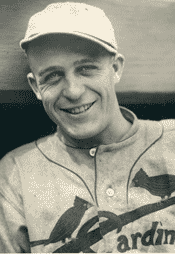
Jim Bottomley
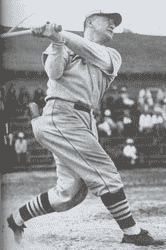
Frankie Frisch
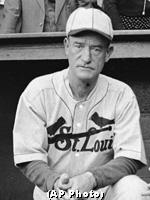
Gabby Street
|
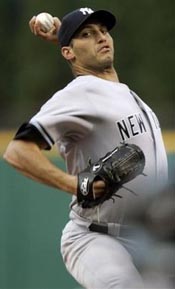
Andy Pettitte
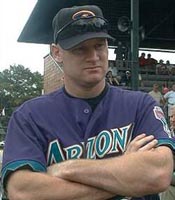
Matt Williams
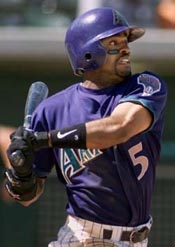
Tony Womack
|
The Yankees led the 2001 World Series three-games-to-two. Joe Torre sent 15-game winner Andy Pettitte for the sixth game back in Arizona.
- The Diamondbacks had beaten Andy 4-0 in Game Two.
- He had pitched well, allowing only five hits, but one of them was a 3-run clout by 3B Matt Williams in the seventh.
Game Six was a different matter entirely. Pettitte lasted less than 3 innings.
- SS Tony Womack led off the bottom of the first with a ground rule double.
- Tony Batista drove him home with a single for the only run of the inning.
Arizona struck for 3 more in the second.
- Again, the leadoff man got on – Williams singled to RF.
- RF Reggie Sanders doubled to deep CF sending Matt to third.
- The runners stayed as 2B Jay Bell grounded out.
- C Damian Miller was walked intentionally to get to P Randy Johnson.
- The Big Unit got his bat on the ball and grounded to 3B Scott Brosius who threw out Williams at the plate.
- Womack singled to CF scoring two and putting Johnson on 2B.
- Bautista singled to LCF to plate the third run of the inning.
- Pettitte caught Luis Gonzalez looking to end the frame.
Inning 3 brought the lefty more misery.
- 1B Greg Colbrunn walked. Unknown to Pettitte, the Dbacks licked their chops as he now had to work from the stretch again.
- Williams doubled to deep RF, scoring Colbrunn.
- Torre brought in Jay Witasick. But the home team continued their onslaught, scoring a total of 8 runs in the inning for a commanding 11-0 lead on their way to a 15-2 victory.
- Pettitte's line for the evening: 2+ innings, 7 H, 2 W, 6 ER.
- Arizona won the Series the next night with a two-run rally in the bottom of the ninth against Mariano Rivera.
Later, it was learned that Pettitte's implosion was not just the result of bad stuff or location. The Diamondbacks had determined that Pettitte was tipping his pitches when he worked from the stretch.
- When he prepared to throw a curve, he would draw his hands from his shoulder level to his waist in an arc, looping his hands in front of him.
- Before throwing his fastball, he would bring his hands straight down to his waist.
- While doing an international broadcast of Game 6, ESPN's Rick Sutcliffe, the 1984 NL Cy Young winner, noticed what Pettitte was doing.
Andy still feels bad about what happened in that fateful Game 6.
- "Basically, I feel like I cost us a World Series ring."
- "To tell you the truth, I don't think it even entered my mind at first. But as soon as someone [Sutcliffe?] came up to me and told me that I might be doing it, I knew it. I knew they had me."
References: "The Insider," Buster Olney, ESPN the Magazine, 6/2010
"Giving It Away," John Donovan, Sports Illustrated, 5/12/2004
|
|
In 18 ML seasons (1921-1938), Leon "Goose" Goslin compiled a .316 average with 1,609 RBIs and 248 HRs for the Washington Senators, St. Louis Browns, and Detroit Tigers. He was voted into the Hall of Fame in 1968 by the Veterans Committee.
On April 28, 1934, Goslin had a bad day at Navin Field in Detroit against the Cleveland Indians.
- Detroit manager Mickey Cochrane had Goose in LF and batting cleanup behind SS Billy Rogell, 2B Charlie Gehringer, and C Cochrane.
- In the third inning, Goslin muffed Earl Averill's fly ball with two outs. Joe Vosmik doubled home Averill with what turned out to be Cleveland's only run of the afternoon off RHP Tommy Bridges.
At the plate, Goose went 0-4, but that only begins to tell the story.
- In the first inning, Goslin steps up against RHP Mel Harder with Gehringer on 3rd and Cochrane on 1st. Goose smashes a grounder to 1B Hal Trosky who steps on the bag and throws to SS Bill Knickerbocker who tags the runner to complete the DP.
- In the third, after making his error, the LF gets a chance to redeem himself. With Gehringer again on third with Cochrane at first, Goose drives a hard grounder to 2B Eddie Moore, who flips to Knickerbocker who relays to Trosky for another twin-killing.
- Fast forward to the fifth, with Thornton Lee on the mound in place of Harder. With one out, Gehringer is on first when Goslin grounds sharply to Trosky who repeats the first inning play by stepping on first and firing to Knickerbocker for DP #3.
- In the 8th inning, RHP Lloyd Brown gives up Gehringer's fourth single of the day. After Cochrane makes the first out, Goslin hits back to the mound for a Brown-Knickerbocker-Trosky twin killing.
Hitting into four DPs in one game constitutes a bad day at the old ballpark by anyone's definition. Goose is listed in the record books along with Joe Torre, who rapped into four twin killings for the Mets on July 21, 1975.
|
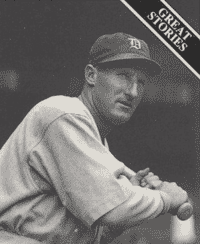
Goose Goslin
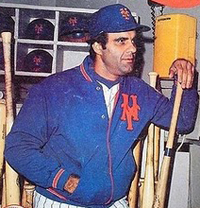
Joe Torre
|
|
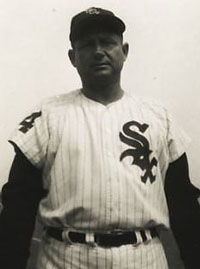
Early Wynn
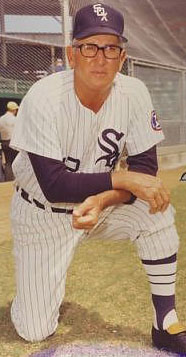
Al Lopez
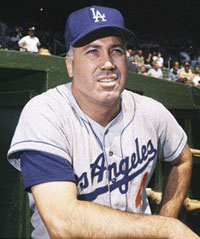
Duke Snider
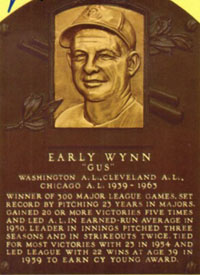
|
At age 39 in 1959, Wynn led the AL in wins with 22 (against only 10 losses) as he played a big role in the White Sox winning their first AL pennant since the infamous Black Sox of 1919. As a result, he won the Cy Young Award when only one was given between the two leagues.
- Opening the World Series against the Los Angeles Dodgers in Comiskey Park, Wynn threw seven shutout innings in the 11-0 Chicago romp.
- He left complaining of a stiff elbow after facing two batters in the eighth.
After the Dodgers captured the next two games, manager Al Lopez called on Wynn to start Game 4 in the Los Angeles Coliseum with three days rest.
- Early gave up a single in the first and then two infield hits in the second.
- The roof fell in on him in the third in part because of shoddy support and several bloody hits.
- After the first two batters were retired easily, Moon singled to LF.
- Norm Larker singled to CF, sending Moon to 3B. When Jim Landis's throw skipped away at the hot corner, Moon scored and Larker reached 2B.
- Gil Hodges singled home Larker.
- Don Demeter stroked the fourth straight single, moving Hodges to 3B.
- A passed ball by C Sherm Lollar allowed Hodges to score and Demeter to reach 2B.
- C John Roseboro blooped a single into RF to plate Demeter with the fourth run.
- At that point, Lopez removed a dejected Wynn.
- The White Sox rallied to tie the game only to lose 5-4 on Hodges' 8th-inning HR.
Chicago pulled out Game 5 1-0 to earn a return trip to the Windy City.
- With a travel day providing a second day of rest and Wynn having pitched less than three innings in Game 4, Lopez called on his ace to keep the White Sox alive in Game 6.
- Early again started well, holding the Dodgers hitless in the first two frames.
- The third again caused problems.
- With two out and none on, Moon walked.
- Veteran CF Duke Snider smashed a HR into the lower stands in LCF.
- The next inning killed the Sox's chances.
- Larker singled, and Roseboro bunted PR Demeter to second.
- SS Maury Wills's single to CF plated Don.
- Johnny Podres doubled off the CF fence, scoring Wills easily.
- Seeing the opposing P clout one convinced Lopez to make a change.
- LA finished with six runs in the inning on their way to a 9-3 romp.
- After the game, Wynn gave no excuses. "I goofed it up good. I was trying to baffle them and it didn't work."
- His line for his last two starts read like this: 6 IP, 13 H, 9 R, 8 ER, 3 BB, 3 K
1959 proved to be Early's last solid season.
- Age finally caught up with him as he dropped to 13 victories in '60 and won only 16 more in the next three seasons combined.
- Wynn retired during the 1963 season, his 23rd in the majors, after he recorded his 300th win.
- He was inducted into the Hall of Fame in 1972.
|
Willie Stargell 1971 Post-Season
By his tenth season with the Pittsburgh Pirates in 1971, 31-year-old Willie Stargell had become the undisputed leader of the team.
- He led the NL in homers that year with 48, 17 more than he clouted the previous season. His 125 RBI ranked second behind Joe Torre of the Cardinals.
- However, Willie also topped the senior circuit in strikeouts with 154.
As the Pirates fought to clinch the NL East crown, Willie went into a mild slump.
- After going 2-for-3 on September 1, Stargell boasted a .303 batting average.
- However, the rest of the regular season, he hit only .242.
- He sat out a week in the middle of the month with a sore knee.
The National League Championship Series against the San Francisco Giants was a disaster for Willie.
- He went hitless in 14 ABs with 0 RBIs.
- He did score a run in Game 5 on Roberto Clemente's HR after being walked intentionally.
- Showing their depth of skill, the Pirates still won the Series three-games-to-one.
Stargell couldn't do any worse than .000 in the World Series.
- He did do better but still didn't excel, garnering 5 hits in 24 ABs against the Orioles for a .208 average.
- He had 1 RBI and one extra-base hit, a double.
- Baltimore pitchers walked him seven times, and he scored three runs.
The sixth game of the Fall Classic at Baltimore provided the low spot for the Pirates' slugger.
- With Pittsburgh ahead three-games-to-two, the contest went into extra innings.
- In the top of the 10th, Dave Cash singled with one out. Cash stole second as Richie Hebner struck out.
- Orioles' manager Earl Weaver ordered Pat Dobson to walk Clemente to get to Stargell. How many times had that happened to Willie that season?
- Needing a win to prolong the Series, Earl brought in southpaw starter Dave McNally, who walked Willie to load the bases.
- Weaver's strategy worked as Al Oliver flied out to leave the bases loaded.
- The Orioles scored in the bottom of the tenth to take the Series to a seventh game, which the Pirates won 3-2.
|
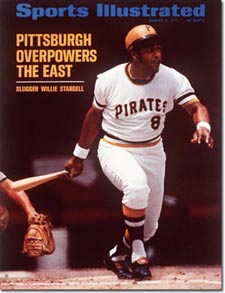
Willie Stargell
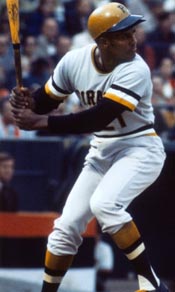
Roberto Clemente
|
|
|




































